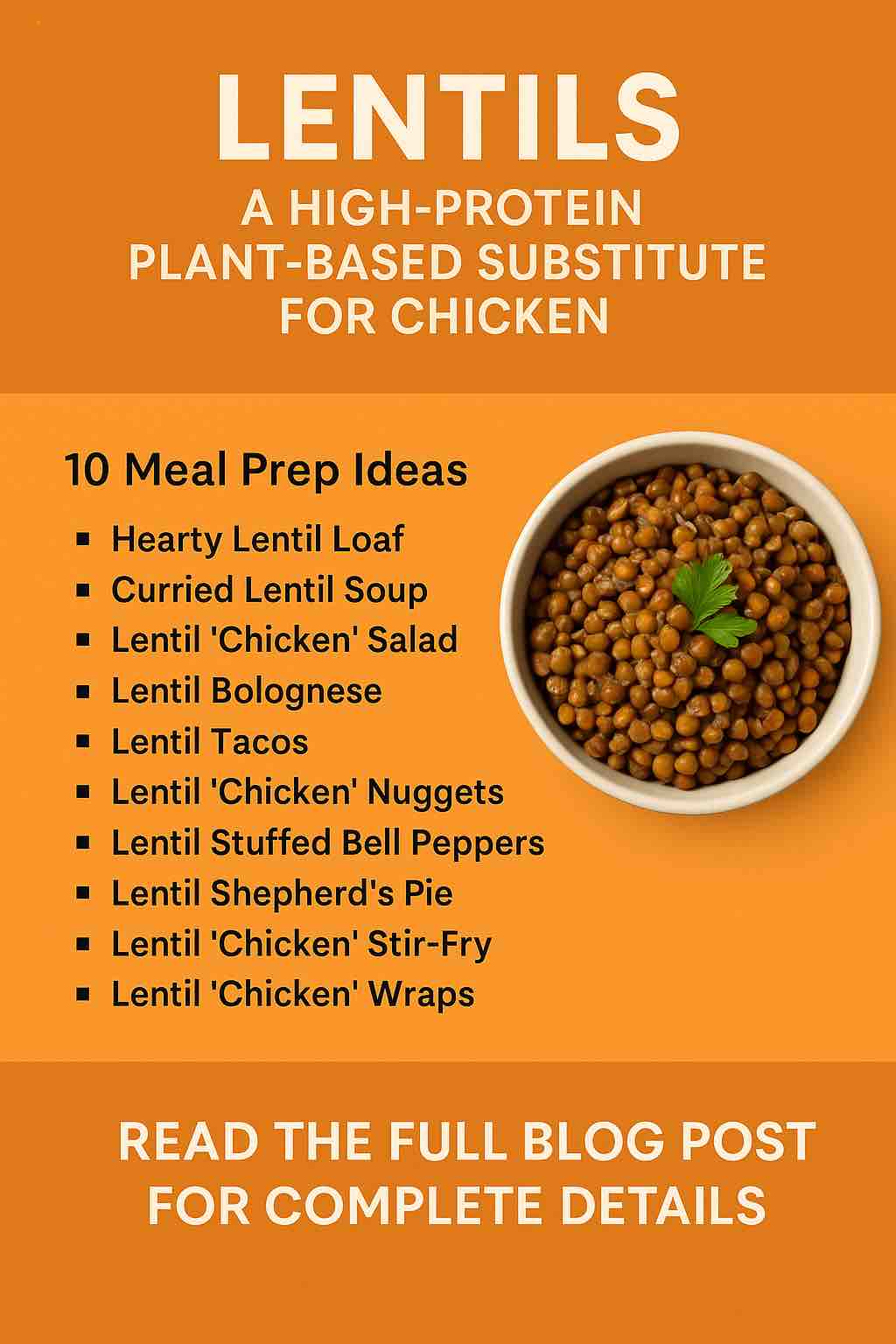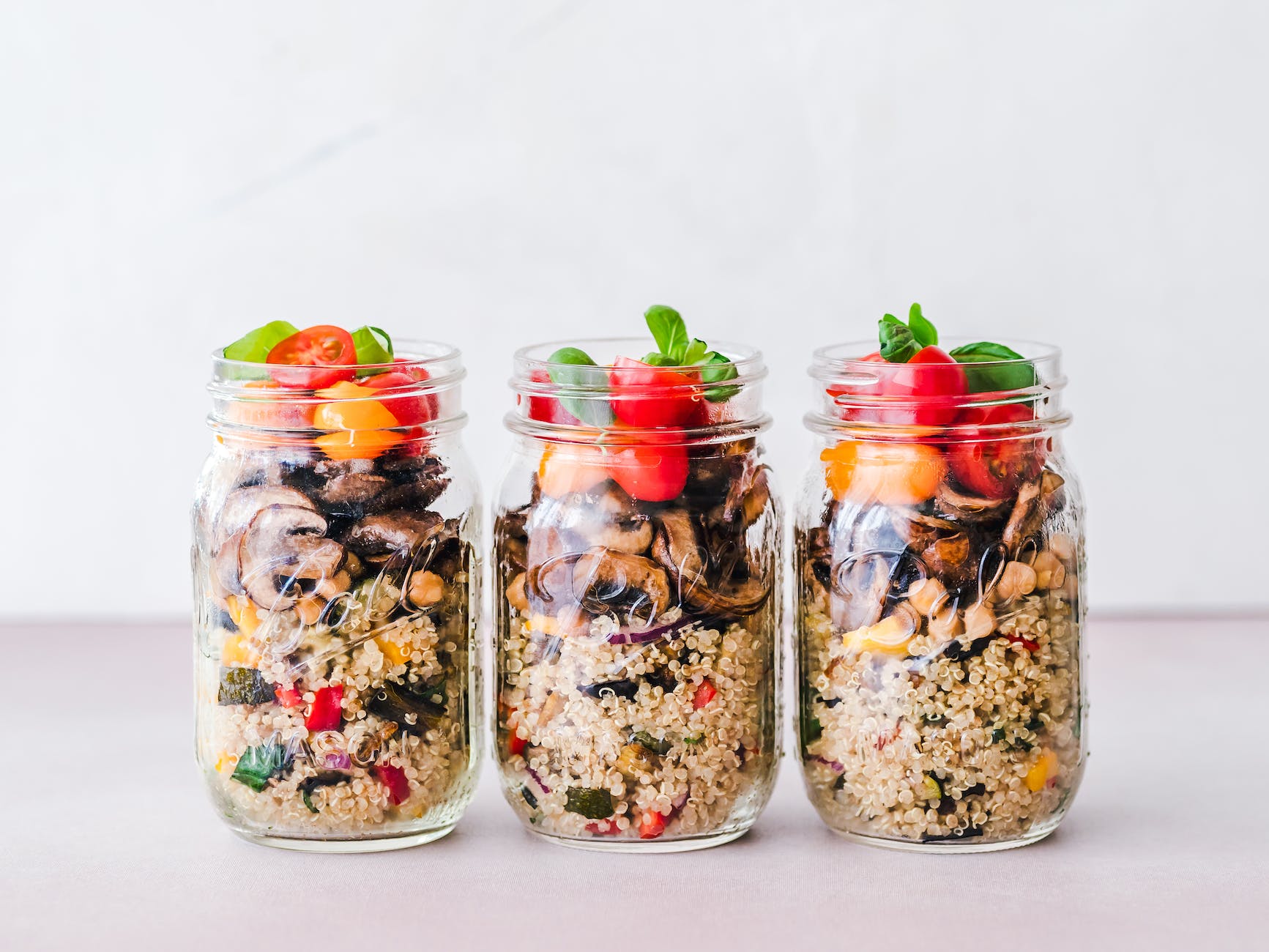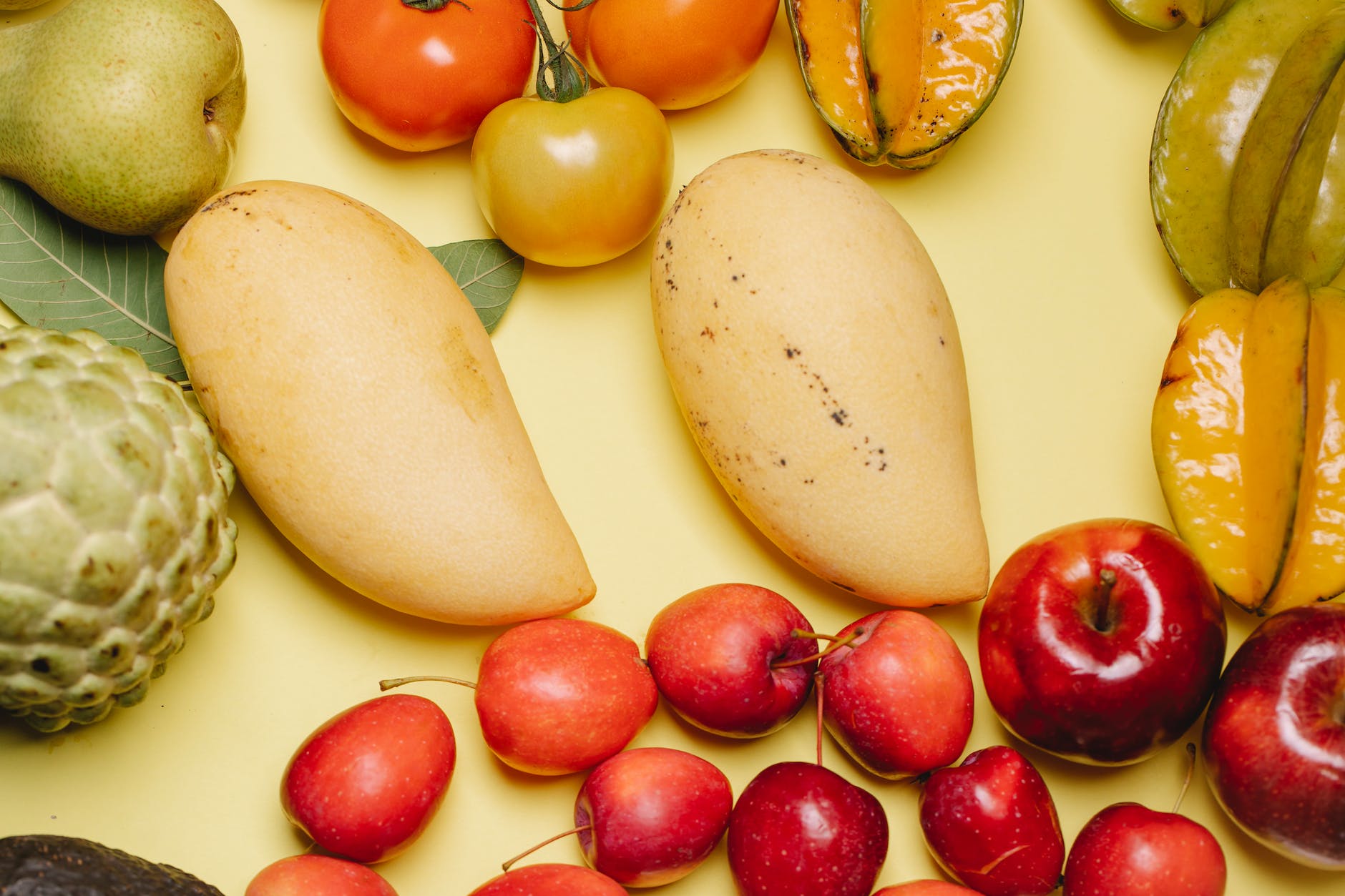
Lentils, with their rich nutrient profile, versatility, and hearty texture, have long been celebrated in plant-based cooking. These tiny legumes are packed with protein, fiber, vitamins, and minerals, making them an ideal replacement for meat in a variety of dishes. Whether you’re looking to add more plant-based protein to your diet or simply seeking a healthier alternative to chicken, lentils offer a robust and satisfying solution. Their ability to absorb spices and flavors means they work beautifully in any recipe, from soups to salads to hearty entrées.
Let’s explore how you can incorporate lentils into your meal prep with 10 high-protein ideas that are perfect for replacing chicken in your favorite dishes. These recipes are not only delicious but also packed with nutrients to keep you fueled throughout the day.
1. Hearty Lentil Loaf
This plant-based twist on the classic meatloaf is just as hearty and satisfying as the original. Made with lentils, vegetables, and spices, it’s the perfect comfort food that’s both healthy and filling.
- Serving Size: 200g
- Macros (per serving): 280 calories, 18g protein, 30g carbs, 7g fat
- Preparation time: 1 hour 10 minutes
Cooking Instructions:
- Sauté onions, garlic, and carrots until softened.
- Combine cooked lentils, sautéed vegetables, breadcrumbs, and your favorite spices in a food processor. Process until the mixture is well combined but still slightly chunky.
- Press the mixture into a loaf pan and bake at 375°F (190°C) until firm and golden, about 45 minutes.
Best Time to Eat: Lunch or dinner
Storage: Keep in an airtight container in the fridge for up to 4 days. Reheat before serving for best texture.
2. Curried Lentil Soup
This nourishing soup is the epitome of comfort food, with warming spices, lentils, and vegetables coming together to create a flavorful, protein-packed meal.
- Serving Size: 300g
- Macros (per serving): 220 calories, 13g protein, 36g carbs, 3g fat
- Preparation time: 45 minutes
Cooking Instructions:
- Sauté onions, garlic, and ginger until fragrant. Add curry powder and turmeric and cook for another minute.
- Stir in chopped tomatoes, lentils, and vegetable broth. Simmer until the lentils are tender.
- For a creamy texture, blend the soup with an immersion blender or in a countertop blender.
- Add a squeeze of lemon juice to brighten the flavors.
Best Time to Eat: Lunch or dinner
Storage: Store in an airtight container in the refrigerator for up to 4 days. Reheat on the stovetop or microwave.
3. Lentil ‘Chicken’ Salad
This creamy, satisfying salad is a perfect plant-based substitute for chicken salad. The lentils provide a meaty texture, and with the addition of vegan mayo and fresh veggies, it’s a wholesome and flavorful dish.
- Serving Size: 200g
- Macros (per serving): 230 calories, 10g protein, 26g carbs, 10g fat
- Preparation time: 25 minutes
Cooking Instructions:
- Mix cooked lentils with diced celery, red onion, vegan mayo, Dijon mustard, apple cider vinegar, and your favorite spices. Stir until fully combined.
- Serve it on its own, with crackers, or as a sandwich filling.
Best Time to Eat: Lunch or dinner
Storage: Keep in an airtight container in the fridge for up to 3 days. Best served chilled.
4. Lentil Bolognese
A protein-rich and satisfying twist on the classic Italian bolognese, this dish uses lentils as a meat replacement to soak up a rich, tomato-based sauce.
- Serving Size: 250g
- Macros (per serving): 280 calories, 15g protein, 45g carbs, 5g fat
- Preparation time: 1 hour
Cooking Instructions:
- Sauté onions, garlic, and carrots in olive oil until soft.
- Add cooked lentils, tomatoes, and vegetable broth. Let it simmer for 25–30 minutes until the sauce thickens and the lentils are tender.
- Serve over whole wheat spaghetti and top with fresh basil or vegan parmesan.
Best Time to Eat: Lunch or dinner
Storage: Store in an airtight container in the fridge for up to 4 days. Reheat before serving.
5. Lentil Tacos
These flavor-packed tacos are a fantastic way to enjoy lentils in a casual, fun meal. Loaded with protein and topped with your favorite fixings, they’re an easy and satisfying option.
- Serving Size: 3 tacos (approx. 200g)
- Macros (per serving): 320 calories, 18g protein, 46g carbs, 6g fat
- Preparation time: 30 minutes
Cooking Instructions:
- Sauté onions and garlic until fragrant, then add cooked lentils, vegetable broth, and taco seasoning. Simmer until the liquid is absorbed and the lentils are well coated.
- Serve the lentil mixture in tortillas and top with fresh toppings such as lettuce, tomato, avocado, and vegan cheese.
Best Time to Eat: Lunch or dinner
Storage: Store the lentil mixture in an airtight container in the fridge for up to 4 days. Assemble tacos just before serving.
6. Lentil ‘Chicken’ Nuggets
These crispy, golden lentil nuggets are a protein-packed snack or meal that’s perfect for a quick and satisfying bite.
- Serving Size: 200g (approx. 6 nuggets)
- Macros (per serving): 300 calories, 19g protein, 40g carbs, 8g fat
- Preparation time: 45 minutes
Cooking Instructions:
- Combine cooked lentils, breadcrumbs, and spices in a food processor until the mixture is thick and sticky.
- Shape the mixture into nuggets and bake at 375°F (190°C) for 25–30 minutes until golden and crispy.
Best Time to Eat: Lunch, dinner, or as a snack
Storage: Keep in an airtight container in the fridge for up to 3 days. Reheat in the oven for best texture.
7. Lentil Stuffed Bell Peppers
These vibrant bell peppers are filled with a delicious mix of lentils, rice, and spices. They’re visually appealing, protein-packed, and perfect for a satisfying meal.
- Serving Size: 2 stuffed halves (approx. 300g)
- Macros (per serving): 310 calories, 14g protein, 58g carbs, 3g fat
- Preparation time: 1 hour
Cooking Instructions:
- Cut bell peppers in half and remove seeds.
- Prepare a filling with cooked lentils, cooked rice, sautéed onions, garlic, diced tomatoes, and your favorite spices.
- Stuff the bell pepper halves with the lentil mixture and bake at 375°F (190°C) for 25–30 minutes until the peppers are tender.
Best Time to Eat: Lunch or dinner
Storage: Store in an airtight container in the fridge for up to 4 days. Reheat before serving.
8. Lentil Shepherd’s Pie
This comforting classic is transformed with lentils, making it a hearty, plant-based dish that’s just as satisfying as the original.
- Serving Size: 250g
- Macros (per serving): 350 calories, 18g protein, 45g carbs, 12g fat
- Preparation time: 1 hour 30 minutes
Cooking Instructions:
- Sauté onions, carrots, and celery until soft.
- Stir in cooked lentils, vegetable broth, and your choice of herbs and spices. Let the mixture simmer until thickened.
- Top with mashed potatoes and bake at 375°F (190°C) for 20–25 minutes until the top is golden and bubbly.
Best Time to Eat: Dinner
Storage: Store in an airtight container in the fridge for up to 4 days. Reheat before serving.
9. Lentil ‘Chicken’ Stir-fry
A quick and easy stir-fry loaded with veggies and lentils, this dish is perfect for a busy weeknight meal.
- Serving Size: 300g
- Macros (per serving): 280 calories, 15g protein, 35g carbs, 9g fat
- Preparation time: 30 minutes
Cooking Instructions:
- Stir-fry your favorite vegetables in a hot pan with a little oil.
- Add cooked lentils and your choice of stir-fry sauce, cooking until the vegetables are tender and everything is well coated.
Best Time to Eat: Lunch or dinner
Storage: Store in an airtight container in the fridge for up to 3 days. Reheat before serving.
10. Lentil ‘Chicken’ Wraps
These wraps are fresh, satisfying, and packed with protein. The perfect meal for lunch or a light dinner!
- Serving Size: 1 wrap (approx. 200g)
- Macros (per serving): 290 calories, 15g protein, 40g carbs, 8g fat
- Preparation time: 20 minutes
Cooking Instructions:
- Sauté onions and garlic until fragrant. Add cooked lentils and spices, then simmer until well combined.
- Fill a wrap with the lentil mixture, lettuce, tomatoes, cucumber, and a dollop of vegan yogurt or your favorite dressing.
Best Time to Eat: Lunch
Storage: Prepare the lentil mixture in advance and store in the fridge for up to 3 days. Assemble wraps just before serving.
Wrap-Up:
These 10 high-protein lentil-based meals are perfect for meal prepping, offering variety, flavor, and nutrition without compromising on taste. From comforting soups to fresh wraps, lentils can easily replace chicken in many of your favorite dishes. Experiment with these recipes and make them your own by adding your preferred spices, veggies, and seasonings.
As always, we’d love to hear how you enjoy these dishes and any creative twists you add! Stay tuned for our next series where we’ll explore even more plant-based protein options. 🌱
FAQs for Plant-Based High-Protein Meal Prep Ideas Using Lentils
1. Can lentils really replace chicken in recipes?
Yes! Lentils are an excellent substitute for chicken in many recipes due to their high protein content, hearty texture, and ability to absorb flavors. They are especially great in dishes like soups, salads, tacos, and even nuggets.
2. How much protein do lentils contain?
Lentils are a great source of plant-based protein, offering approximately 18g of protein per cooked cup (about 200g). This makes them a perfect alternative for chicken in protein-packed meals.
3. Are lentils difficult to cook?
Not at all! Lentils are easy to cook and don’t require soaking like other beans. They can be cooked in 20-30 minutes, depending on the type of lentil. Red lentils cook faster, while green and brown lentils take a little longer.
4. How do I store lentil-based meal prep dishes?
Most lentil-based meals can be stored in an airtight container in the refrigerator for up to 4 days. If you want to keep meals for longer, consider freezing them for up to 3 months. Be sure to reheat thoroughly before eating.
5. Can I use canned lentils instead of dried lentils?
Yes, you can! Canned lentils are a convenient option, and they can be used as a substitute for cooked lentils in most recipes. Just be sure to drain and rinse them well to remove excess sodium.
6. Are lentils suitable for all dietary restrictions?
Lentils are naturally gluten-free and plant-based, making them suitable for vegan, vegetarian, and gluten-free diets. However, always check for any added ingredients in pre-packaged lentils (like canned lentils or pre-cooked lentil meals) to ensure they align with your dietary needs.
7. Can I add lentils to my existing chicken recipes?
Absolutely! Lentils can be easily swapped for chicken in many recipes. For example, you can add cooked lentils to a chicken salad, or use them instead of chicken in stir-fries, wraps, or tacos. Adjust the seasoning to fit the flavor profile of your dish.
8. How can I make lentil dishes more flavorful?
Lentils absorb flavors beautifully, so be sure to season them well with herbs, spices, and aromatics like garlic, onions, and ginger. Adding ingredients like lemon juice, tamari, coconut milk, or tomato paste can elevate their taste and make them even more delicious.
9. Are lentil-based meals high in fiber?
Yes! Lentils are a fantastic source of dietary fiber, which helps with digestion and can contribute to a feeling of fullness. On average, one cup of cooked lentils provides around 15-16g of fiber.
10. Can I freeze lentil-based dishes for later?
Yes, lentil dishes freeze very well. Make sure to cool them completely before placing them in an airtight container or freezer-safe bag. When ready to eat, simply thaw in the refrigerator overnight and reheat on the stove or in the microwave.












